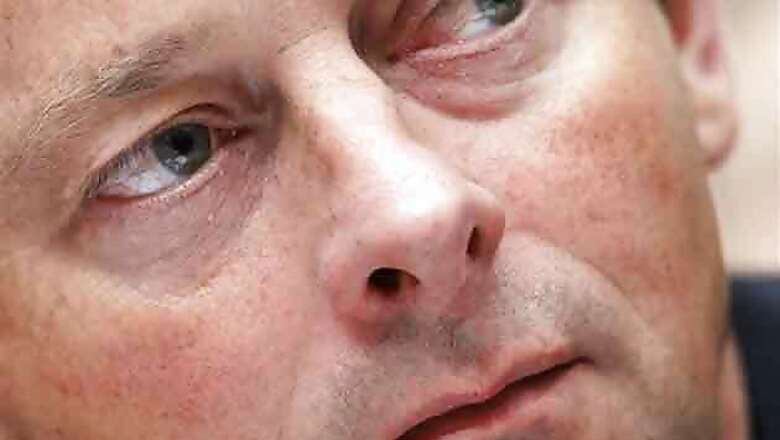
views
London/Houston: BP Plc on Wednesday denied a report its heavily criticized chief executive would soon leave, after the company lined up $ 7 billion in asset sales to help pay for the worst oil spill in U.S. history.
CEO Tony Hayward had the full support of the board and would stay in office, a BP spokesman told Reuters, dismissing a report in the Times newspaper that he would step down within the next 10 weeks.
Hayward has been roundly criticized for a series of PR gaffes and a failure to quickly stem the three-month leak in the Gulf of Mexico, prompting speculation he would be removed.
Hayward would have to step down so that BP could build its defenses against a potential buyout threat by ExxonMobil or Royal Dutch Shell, the Times cited a person close to the matter as saying.
There was a growing expectation that he would announce his departure in late August or September, with Robert Dudley, chief of BP's Gulf Coast restoration efforts, viewed as the front-runner to replace The Times said.
BP is also selling assets around the world to help shore up its finances after pledging to set aside $ 20 billion to meet the costs of the spill.
The company said on Tuesday it reached a $ 7 billion deal with U.S. firm Apache Corp, a large part of its planned sale of $ 10 billion in assets.
BP said Apache would pay a $ 5 billion cash deposit on July 30 as part of the deal for exploration and production facilities in North America and Egypt. The company said the deal would include assets in New Mexico, natural gas in western Canada and concessions in Egypt.
Earlier, it announced it would sell $ 1.7 billion worth of assets in Vietnam and Pakistan.
BP's share price ended 1.5 percent lower in New York at $ 35.20, but was up 1.3 percent in afterhours trading.
The stock has fallen 40 percent in the three months since an explosion on an offshore rig killed 11 workers and caused the crude to flow into the Gulf of Mexico.
The continuing disaster remains high on the American and British political agendas and dominated a visit to Washington by British Prime Minister David Cameron.
Cameron praised BP for steps it has taken to plug the leak and pay for damages suffered by Gulf residents. U.S. officials on Tuesday gave BP's latest effort, a cap that has stopped the flow, another 24 hours for pressure tests on the seal.
The Gulf's tourism and fishing industries have been devastated by the millions of gallons of oil that have hit coastal beaches and marshes. The spill also has hurt President Barack Obama's approval ratings.
About 1.6 million barrels of oil remain in the Gulf, Louisiana Governor Bobby Jindal said, citing U.S. government data.
Rig operator Ensco Plc filed a lawsuit on Tuesday challenging the Obama administration's new deepwater oil drilling moratorium, saying it was mostly the same as the first ban that a U.S. court already put on hold.
BP, which said on Monday it had spent about $ 3.95 billion so far on the oil spill, agreed under intense U.S. pressure from last month to set up an independently administered $ 20 billion escrow fund for damage claims. The Obama administration has stressed that is not a cap on the company's liabilities.
During a visit with Obama, Cameron said he understood U.S. anger at BP because of the oil spill. He also said it was important to both the U.S. and British economies that the company stay strong and stable.
Al Troner, president of Asia Pacific Energy Consulting in Houston, said Hayward was not entirely responsible for the disaster, although "he seems to have an unfortunate tendency to put both his feet in his mouth."
"There is more than enough blame to spread around here, whether it's BP, the drilling company, or the federal government reaction" he said.
The U.S. government on Tuesday approved another 24-hour extension of a pressure test of the well. The broken well was capped last week -- at least temporarily -- after spilling up to 60,000 barrels a day of crude for three months.
The well test, which has been extended in 24-hour increments by the U.S. government, will continue until Wednesday afternoon and then be re-evaluated.
Scientists are now weighing another option -- a "static kill" to help smother and plug the leak.
The top U.S. oil spill official, retired Coast Guard Admiral Thad Allen, said BP could have a plan to proceed with the static kill option within 24 hours. This would involve pumping heavy drilling mud and possibly cement into the well, much like BP's failed "top kill" in May.
Kent Wells, BP's senior vice president of exploration and production, said the static kill would be different because the well is no longer spewing oil, thanks to the sealed cap. During the top kill effort, drilling mud pumped into the blowout preventer shot out of an uncovered pipe at the top along with leaking crude.
Such containment efforts are keenly eyed by investors as BP's ultimate costs from the spill may hinge on how much oil is determined to have been spilled into the Gulf.
Louisiana residents remain cautiously optimistic about the seal that has stopped the flow for now, but concerns remain.
"I am happy it's stopped the flow," said New Orleans resident Barbara McGuinness. "But do I worry about this thing blowing? Yes. We don't need any more bad news."




















Comments
0 comment